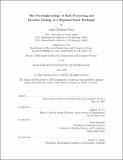| dc.contributor.advisor | Andrew W. Lo and Peter Szolovits. | en_US |
| dc.contributor.author | Perry, John Christian, 1971- | en_US |
| dc.contributor.other | Massachusetts Institute of Technology. Dept. of Electrical Engineering and Computer Science. | en_US |
| dc.date.accessioned | 2008-02-27T20:38:14Z | |
| dc.date.available | 2008-02-27T20:38:14Z | |
| dc.date.copyright | 2007 | en_US |
| dc.date.issued | 2007 | en_US |
| dc.identifier.uri | http://hdl.handle.net/1721.1/40319 | |
| dc.description | Thesis (Ph. D.)--Massachusetts Institute of Technology, Dept. of Electrical Engineering and Computer Science, 2007. | en_US |
| dc.description | This electronic version was submitted by the student author. The certified thesis is available in the Institute Archives and Special Collections. | en_US |
| dc.description | MIT Barker Engineering Library copy printed in leaves. | en_US |
| dc.description | Includes bibliographical references (p. 209-215). | en_US |
| dc.description.abstract | A longstanding controversy in philosophy is whether decision-making is governed by reason or emotion. I study the role of physiological responses in the decision-making process within the realm of financial markets, where both the environment and decisions-trades-are measurable. In an experiment performed on a regional stock exchange, my collaborators and I record six different types of physiological signals-skin conductance/galvanic skin response (SCR/GSR), blood volume pulse (BVP), electrocardiogram (ECG), electroencephalogram (EEG), electromyogram (EMG), and temperature (Temp)-of monetarily motivated professionals making high pressure decisions. From these signals I estimate underlying physiological features, such as heart rate, changes in body temperature, and amplitude of SCR, which are proxy for affect. Simultaneously, we record real-time market information which the specialists process and which serves as the basis for their decisions, as well as recording their decisions and outcomes. In a sample of eight market-makers, I find statistically significant differences in mean skin conductance response and cardiovascular variables during transient market events relative to no-market-event control intervals. In addition, I find a strong relationship between trading decisions and physiological responses. Using regression, I demonstrate that heart rate variability can statistically significantly improve predictions of trading decisions, although not by much. | en_US |
| dc.description.statementofresponsibility | by John Christian Perry. | en_US |
| dc.format.extent | 215 p. | en_US |
| dc.language.iso | eng | en_US |
| dc.publisher | Massachusetts Institute of Technology | en_US |
| dc.rights | M.I.T. theses are protected by copyright. They may be viewed from this source for any purpose, but reproduction or distribution in any format is prohibited without written permission. See provided URL for inquiries about permission. | en_US |
| dc.rights.uri | http://dspace.mit.edu/handle/1721.1/7582 | |
| dc.subject | Electrical Engineering and Computer Science. | en_US |
| dc.title | The psychophysiology of risk processing and decision making at a regional stock exchange | en_US |
| dc.type | Thesis | en_US |
| dc.description.degree | Ph.D. | en_US |
| dc.contributor.department | Massachusetts Institute of Technology. Department of Electrical Engineering and Computer Science | |
| dc.identifier.oclc | 191825845 | en_US |
